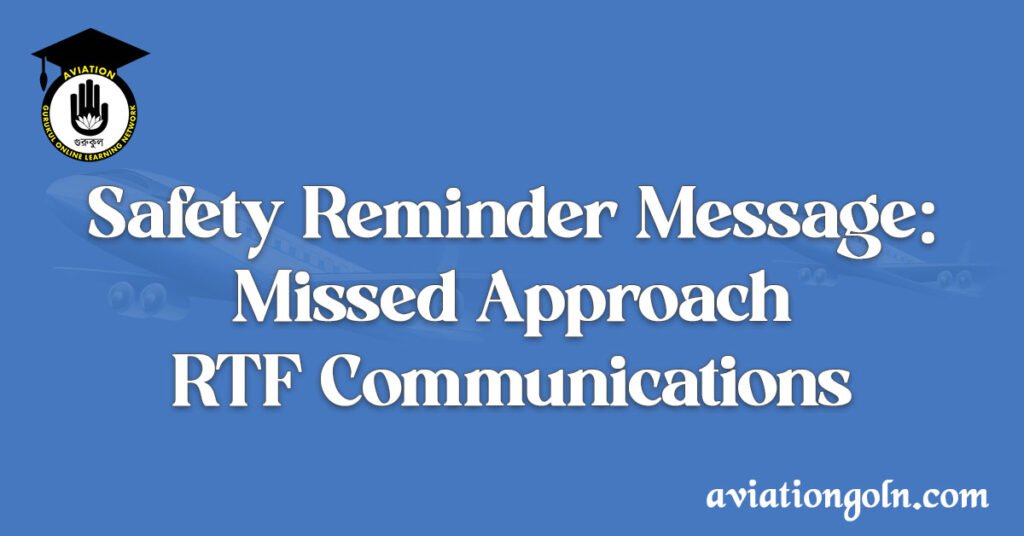Safety Reminder Message: Missed Approach RTF Communications, Safety in aviation is the pinnacle of concern for all stakeholders. From pilots to air traffic controllers, everyone plays a vital role in ensuring flights take off, proceed, and land safely. Communication, especially in critical scenarios such as missed approaches, is the backbone of this safety structure. This article delves into the safety reminder message dated 20090421, focusing on missed approach radio telephony (RTF) communications, to underscore its importance and offer best practices for safety.
Safety Reminder Message: Missed Approach RTF Communications
Background
In aviation, a missed approach refers to the scenario where an aircraft cannot land after making its final approach and must climb away from the airport for another attempt or divert to another airport. This could be due to various reasons – runway obstructions, sudden change in weather conditions, unstable approach, or even an instruction from air traffic control (ATC). When this happens, clear and concise communication becomes vital.
On the date mentioned, 20090421, there were incidents that highlighted potential vulnerabilities in the RTF communications system during missed approaches. As a result, this safety reminder message was dispatched as a proactive measure to bring attention to the importance of efficient communication in these situations.
The Importance of Clear RTF Communications During a Missed Approach
- Safety: The foremost reason is safety. When an aircraft misses its approach, it is potentially in the path of other aircrafts, be it those in holding patterns or those on their final approach. Proper communication ensures these aircraft are aware of each other and can maintain safe separation.
- Efficiency: Air traffic, especially around busy airports, is tightly coordinated. Delays or disruptions can have a cascading effect, leading to increased fuel consumption, passenger inconvenience, and logistical challenges. Clear communications during a missed approach allow ATC to quickly re-sequence aircraft as necessary.
- Pilot & Crew Awareness: A missed approach can be a high workload situation for pilots. Clear communications ensure that they receive timely and accurate information to make the best decisions for the safety of their aircraft and passengers.
- Reduction in Human Error: In high-pressure situations, human error becomes a significant risk. By establishing and adhering to standardized communication protocols, the risk of misunderstandings or mistakes is significantly reduced.
Best Practices in Missed Approach RTF Communications
- Pre-Flight Briefing: Pilots should always be briefed about the missed approach procedures specific to the destination airport. Understanding these procedures beforehand ensures that they are prepared to execute them if necessary and know what communications to expect.
- Standardized Phraseology: Using standardized phrases minimizes confusion. For example, instead of saying “We’re going around,” the international standard phrase is “Going around.” This standardization ensures that both pilots and ATC clearly understand the message being conveyed.
- Immediate Notification: Pilots must notify ATC immediately upon initiating a missed approach. This allows ATC to provide necessary instructions or clear other aircraft out of the way.
- Repeat Back: Given the importance of the instructions, pilots should always repeat back the ATC’s instructions during a missed approach. This ensures both parties have a clear understanding.
- Keep it Short and Clear: In such scenarios, it’s crucial to keep communications brief and to the point. Avoid unnecessary chatter.
- Stay Calm: While it’s easier said than done, it’s crucial for both ATC and pilots to remain calm during these situations. Panic can lead to mistakes, so even in stressful situations, maintaining a cool demeanor is paramount.
- Regular Training: Pilots and ATC personnel should regularly train for missed approach scenarios, ensuring that communication protocols are second nature.
- Use of Technology: Modern aircraft are equipped with advanced communication systems. Using technology to highlight or reinforce verbal communication can be beneficial. For instance, some systems can send digital missed approach notifications to ATC.
Addressing the Challenges
While best practices are known, it’s essential to understand and address the challenges that may hinder efficient RTF communications during a missed approach:
- Over-reliance on Technology: While technology is an enabler, over-reliance can be a challenge. Systems can fail, and when that happens, pilots and ATC must be prepared to handle the situation without them.
- Workload: As mentioned, missed approaches can be high-workload scenarios. Efforts should be made to ensure that pilots and ATC are not overwhelmed, which could impair their communication capabilities.
- Language Barriers: In international aviation, English is the standard language. However, accents or non-native speakers can sometimes lead to misunderstandings. Regular language proficiency checks and training can help mitigate this.
- Cultural Differences: In some cultures, it might be considered impolite to interrupt or speak out of turn. These cultural norms can sometimes impact aviation communication. Awareness and training can help bridge these cultural gaps.
Communication is the bedrock of safety in aviation. While technology and systems are continually evolving, the human element remains central to the process. As such, continuous emphasis on clear, concise, and efficient RTF communications, especially during critical scenarios like missed approaches, will always be essential.
Safety reminder messages, such as the one dated 20090421, serve not just as reactive responses to incidents but as proactive measures to enhance the safety ecosystem’s robustness. They remind us of the continual learning process that aviation is and the shared responsibility that all stakeholders have in ensuring the skies remain safe for everyone.
See more:

